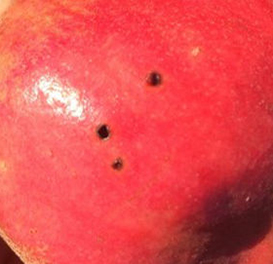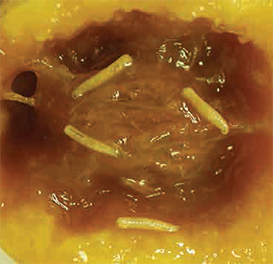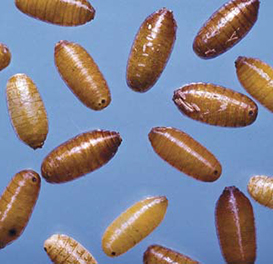Developmental stages
Typically, fruit flies lay their eggs in semi-mature and ripe fruit. The female fruit fly has a retractable, sharp ovipositor at the tip of the abdomen for egg-laying, which is used to insert eggs into the fruit.
An egg clutch can range from several to 50 eggs and a single female can lay several hundred to 3000 eggs in their lifetime, depending on the species (Christenson and Foote 1960).

Damage to fruit caused by Queensland fruit fly. Image courtesy of Queensland Department of Agriculture and Fisheries
Tephritid fruit fly eggs are white, banana shaped and nearly 1 mm long. In two or three days, larvae (maggots) hatch from the eggs and burrow through the fruit.
To the naked eye the larvae resemble blowfly maggots. They are creamy white, legless, blunt-ended at the rear and tapered towards the front where black mouth hooks are often visible.
Female flies may have an association with bacteria resident in their gut in some regions of Australia, which they regurgitate onto the fruit before ovipositing.
Most of the damage sustained by the fruit is caused by the bacteria and the maggots simply lap up the juice.
A pair of mouth hooks allows the larvae to readily tear the fruit flesh.

Queensland fruit fly larvae. Image courtesy of Agriculture Victoria
The larvae develop through three larval stages (instars) and are 9 mm long pale creamy-yellow when fully grown. When fully developed they leave the fruit, burrowing about 5 cm into the soil beneath the tree to form a hard, cream to brown, barrel-like pupal case from its own skin where it completes its development.
Most insects cannot pupate successfully in the presence of excess moisture and fruit fly larvae have a prepupal stage when they can ‘flick’ themselves over some distance, presumably to distance themselves from the host fruit or predators.

Queensland fruit fly pupae. Image courtesy of Queensland Department of Agriculture and Fisheries
The duration of pupal developmental is dependent on temperature with each stage taking from nine days to several weeks to complete.
Adult flies emerge from their pupal cases in the soil and burrow towards the surface where they inflate their wings and fly away. Adults are able to mate within a week of emerging, living for many weeks, with females continuing to lay eggs throughout their lifecycle.
Adult fruit flies feed on carbohydrates from sources such as damaged fruit and honeydew, the sweet secretion from aphids and scale insects, as well as natural protein sources, including bird droppings and bacteria (Christenson and Foote 1960; McKenzie et al. 2004).